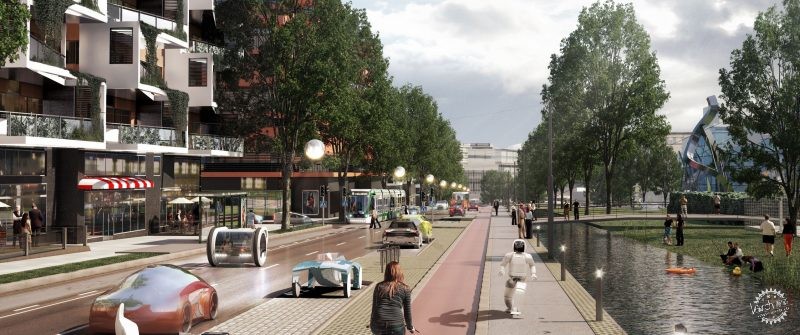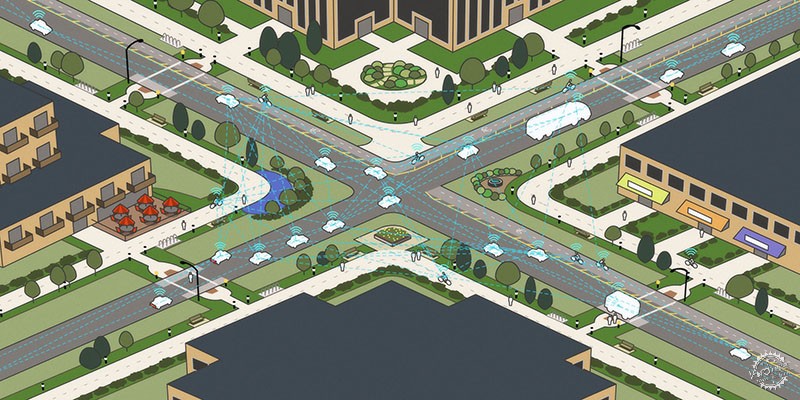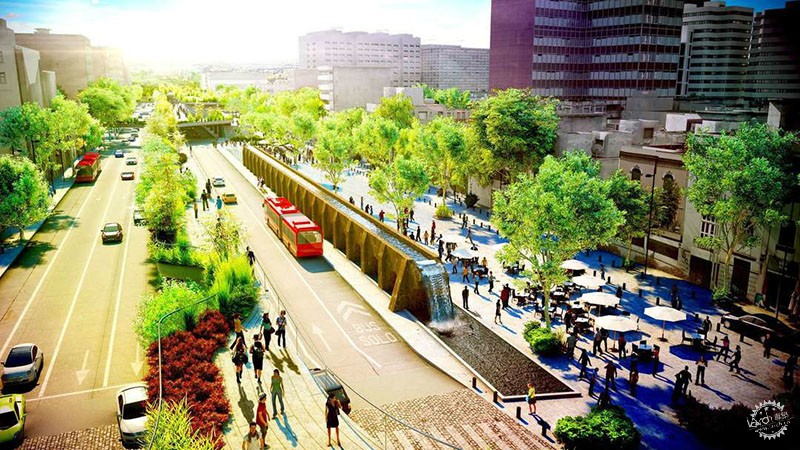
自动驾驶汽车如何影响城市设计
How Autonomous Vehicles are Influencing Urban Design
由专筑网孙佳,李韧编译
自动驾驶汽车的进步超出人们想象。NVIDIA首席执行官Jensen Huang表示,到2022年,全自动汽车将全面上市,而奥迪美国公司负责人Scott Keogh承诺,奥迪公司在2020年就可以购买首款自动驾驶汽车。
那么,随着自动驾驶汽车(AV)市场的快速发展,城市设计会面临哪些挑战?自动驾驶汽车将如何影响城市的结构?
形成全新的行车模式?
在20世纪末,城市和郊区已经充斥着不少私人车辆,然而,最近私人车辆有所减少,这种现象来源于诸如Uber和Lyft的车辆共享服务。
变革的驱动力
城市道路上车辆数量对于城市结构已经造成影响。诸如Berges de Seine Paris和 Rhone River Bank Lyon等项目展示了曾经由汽车主导的城市空间如今皆转换为公共开放空间。
The rise in autonomous vehicles is happening faster than many people think. NVIDIA CEO, Jensen Huang,says that fully automated vehicles will be on our roads by 2022, while Scott Keogh, Head of Audi America has promised that Audi would have its first self-driving cars ready to purchase by as early as 2020.
So, with the rapid acceleration of the autonomous vehicle (AV) market; what are the main challenges we face as urban designers? And how will autonomous vehicles affect the urban fabric of our cities?
Towards a New Autopia?
Throughout the latter half of the 20th century, our urban and suburban environments have been primarily designed for private car use. However, there has been a recent reduction in the ownership of private vehicles. Thanks to on-demand ridesharing services like Uber and Lyft, and specific vehicle demand management policies.
Drivers of change
The reduced number of vehicles on our roads has already begun to shape the fabric of the city. Projects like Berges de Seine Paris and Rhone River Bank Lyon show how spaces in the city that were once dominated by the automobile can be converted to public open spaces that serve the city and its inhabitants.

Berges_du_Rhone_Pont_Guillotiere by ThomasBigot
这个趋势将持续发展,随着相关技术的发展,此类项目会愈发普遍,而越来越多的消费者和公司的消费能力提升,这将推动人们对自动驾驶汽车的需求。一些专家预测,到2040年,自动驾驶汽车的销售量将达到每年3300万辆,约占汽车总销量的四分之一。
一家专注于技术发展的公司Rethink认为,由于共享汽车的诞生,私人汽车数量将减少,其中大量的自动驾驶车队由私营公司拥有。然而,最近Uber公司的自动驾驶汽车事故引起了大众的怀疑。
最后,关于自动驾驶汽车的推动策略有些滞后,“ 全球自动驾驶汽车调查”指出,在美国只有33个州的立法涉及自动驾驶汽车,而英国、荷兰和瑞典等国家则已制定了全面的自动驾驶汽车相关法案。但是仍然有一些国家并没有此类法规。
更新硬件来满足软件
如果到2030年,街道上的自动汽车比例超过四分之一,那么城市的结构就应当相应调整,从而适应变化。
目前,自动驾驶汽车使用LiDAR进行道路扫描。这项技术的适合距离为100-200米。然而,结合路边传感器,该设备可以将道路、天气和意外状况等信息同时传递给所有车辆。人们未来可能需要在街道上安装某种形式的传感设备。那么问题的关键便在于这种设备如何融入街景,这意味着并非只是简单的街道环境改造,而是整个道路系统都要经过调整。
This is a trend set to continue. As any technology (and its associated manufacturing techniques) develops it becomes cheaper. This will drive the demand for AVs as more consumers and companies will be able to afford the technology. Some experts predict that sales of AVs will pass 33 million a year by 2040 (representing one-quarter of all car sales).
Rethink (a think tank focused on the future of technology) believes that private car ownership will reduce in favour of on-demand services where massive fleets of AVs are owned by private companies. However, the recent tragic events of Uber’s fatal autonomous vehicle accident has spread skepticism among the media.
Finally, the policy on how AVs may be driven in our cities is somewhat behind the technology and implementation. The Global Survey of Autonomous Vehicle Regulations notes that only 33 US states have legislation covering self-driving cars on public roads, and other countries like the UK, Netherlands and Sweden only have fully enacted legislation covering the testing of autonomous vehicles. Many other countries have no legal framework covering AVs.
Updating the hardware to meet new software
If by 2030 some 25% of cars on the road will be AVs, we should be adapting our cities now to accommodate this change and preparing for the time when all cars will be autonomous.
Currently, AVs use LiDAR to scan the road ahead. This technology is best at reading the road ahead at between 100-200 m. However, by incorporating roadside sensors along the length of a road, information about road condition, weather, and unexpected events can be relayed to all cars simultaneously. It is likely we shall need to accommodate some form of sensing equipment along our streets in the future. A key challenge is how this is incorporated into the streetscape and could mean the difference between an ugly retro-fitted solution, and a properly integrated system that augments the built environment.

Image courtesy of Short Elliott Hendrickson Inc. (SEH®) http://www.sehinc.com
运用自动驾驶汽车的又一好处是对行人而言更加安全与方便,当前的城市道路设计使得行人不得不通过道路交叉口、天桥、地下通过而过马路。计算机的反应时间非常快,因此行人与汽车可以共同在道路上安全地前行,而对行人来说,更加便捷的交通方式也会产生积极的心理效应,从而减少犯罪率。
汽车数量的减少,汽车的空间需求也相应降低。专家预测,即使汽车数量没有大幅下降,交通流量自动化也意味着车辆的高密度行驶。因此,城市道路会变得窄一些。在现有的城市地区,这意味着人行道的宽度增加,同时结合诸如城市公园、可持续城市排水系统、无人机输送通道等其他街道功能。
当所有的车辆能够自行驾驶时,车辆道路标志和交通信号灯的需求也大大降低。这让有些杂乱无章的街道变得井然有序。只是,仍然需要考虑道路导航的问题,但是这方面问题只需要考虑行人即可。
公园替代停车场
共享汽车的使用节约了大量的时间和成本,而自动驾驶车辆则可以通过实时系统自动寻找停车位,它还将能够将乘客安全地送达目的地,然后再完成载客或充电等目标。减少停车设施将为城市腾出更多空间,例如由James Corner Field Operations设计的Tongva公园。
就小规模而言,私人汽车的减少意味着专用车库和车道的减少,这将大大影响住房设计和城市密度。
One benefit of better connected AVs is the opportunity to give higher priority to pedestrians. The present car-centric design of our cities means that pedestrians are forced to walk to the nearest road junction or underpass to safely cross the road. With cars being driven by computers with faster reaction times, truly shared surfaces can be used throughout the city. A walkable city with a more attractive environment for pedestrians can have dramatic effects including lower crime, physically and mentally healthier citizens, and increased property prices.
With reduced numbers of cars comes reduced spatial requirements. Even if numbers of cars do not fall dramatically, some experts predict that efficiencies in automating traffic flows mean vehicles will be able to drive at higher densities. Roads will, therefore, be able to be narrower, with fewer lanes. In existing urban areas this means wider sidewalks that can accommodate other functions such as linear parks, sustainable urban drainage systems and dedicated drone delivery lanes.
When 100% of vehicles are self-driving, there will no longer be a need for vehicular road signage and traffic lights. This presents an opportunity to de-clutter our streetscapes and come up with innovative new solutions to allow AVs to communicate with each other. Pedestrian wayfinding will remain a consideration, but without the need to display signage for motorists, we can rethink how people navigate the city.
Parks instead of parking
The use of shared on-demand vehicles will reduce the redundancy of cars as they are in use for longer periods of time. Real-time relaying of information directly to AVs will reduce the time spent searching for parking places. Self-driving cars will be able to drop off their passengers at their destination, and then leave to either pick up a new passenger or find a centralized parking and charging location. The reduction in localized car parking facilities will free up more space in the city for parks such as at Tongva Park in Santa Monica by James Corner Field Operations.
On a smaller scale, the reduced ownership of cars will result in private homes not requiring dedicated garagesand driveways. This will affect housing design allowing for the development of a higher density within cities and the suburbs.

文化走廊项目/The Cultural Corridor Chapultepec by FR-EE – http://www.fr-ee.org
未来的城市
在过去60年中,私人汽车逐步成为城市道路的主要要素,但是,自动驾驶汽车的兴起促进了一些挑战和机会,而城市规划方式也应当遵循其发展模式。
自动驾驶车辆的增加将为城市带来更多的绿色基础设施空间。原有的停车区域可以改造为城市公园,宽阔的林荫大道和城市高速公路可以改造为城市绿道。道路逐步更窄,从而满足可持续城市排水系统和基础设施。在一座步行城市,行人可以获得更高的优先权,这将有益于人们的身心健康。
自动驾驶汽车背后的技术正在快速发展。虽然一些政策和基础设施仍然相对缺乏,但设计师应当着眼于未来的转变,以自动化的前提构思城市的发展。
Future cities
For the last 60 years or so, the private car has dominated urban design. But the rise in autonomous vehicles presents some unique challenges and opportunities to reassess how our cities are designed.
The increase in on-demand driverless vehicles will result in more space in our cities for green infrastructure. Areas that were once dominated by localized parking lots can be converted into pocket parks. Wide boulevards and urban highways can be repurposed into pleasant greenways. Roads can become narrower, allowing for better sustainable urban drainage systems and blue infrastructure. Higher priority can be given to pedestrians in truly walkable cities that will benefit our mental and physical health.
The technology behind autonomous vehicles is progressing at a fast pace. While policy and infrastructure design might be slightly behind the technological advances, it is time designers started to think about the changes that will come and plan for a future in which the car is no longer.
|
|
